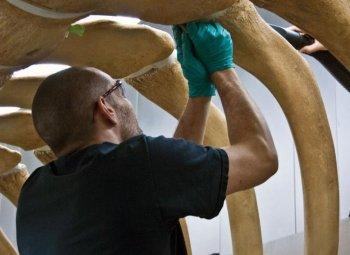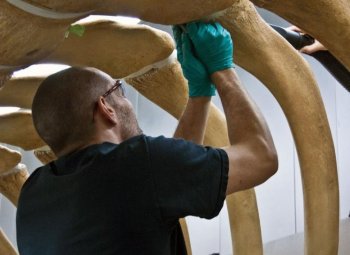How do you exhume, disassemble, then reconstruct the skeleton of an immense blue whale that has been dead for 23 years? With quite a bit of difficulty, it turns out.
The story of the blue whale skeleton that will soon open for public viewing at the University of British Columbia begins on Prince Edward Island’s remote northwestern coast where the whale died in 1987.
The whale was buried near the town of Tignish, P.E.I., and that’s where it remained until Andrew Trites decided to dig it up and put it on display at UBC’s new Beaty Biodiversity Museum.
Trites, director of UBC’s Marine Mammal Research Unit and leader of the effort to recover the 26-metre skeleton and prepare it for exhibit, says he realizes now that he had no idea what he was letting himself in for.
“It’s certainly not what I had thought I was getting into when I first suggested, ‘Why don’t we get a blue whale?’ It was one thing to say something so simple, but it was another thing once we were faced with the reality of what’s involved to dig up the largest animal that’s ever lived on the planet,” he says.
The first surprise came with the discovery that the carcass had hardly decomposed at all.
“It was a shock as we dug through this frozen red soil to discover a very bluish-tinged skin and in fact to realize that the whole whale was still there intact after being underground for 20 years. It was something that none of us had predicted,” Trites says.
It took eight days for a team from UBC along with volunteers from the University of P.E.I. that included biologists, carpenters, veterinary pathologists, knife sharpeners, and machinery operators to excavate the carcass and separate the stinking flesh from the bones.
“We left all the very, very smelly meat and just brought the smelly, smelly bones back,” says Trites. “The bones were just full of rancid oil. I don’t know how many people have smelled rancid oil before, but when it goes rancid you cannot be in the same room with it, it’s so powerful.”
One of the biggest challenges of the whole undertaking was removing the oil from the bones, some of which are sponge-like and extremely porous. Trites notes there isn’t much precedent for degreasing the bones of a blue whale.
The story of the blue whale skeleton that will soon open for public viewing at the University of British Columbia begins on Prince Edward Island’s remote northwestern coast where the whale died in 1987.
The whale was buried near the town of Tignish, P.E.I., and that’s where it remained until Andrew Trites decided to dig it up and put it on display at UBC’s new Beaty Biodiversity Museum.
Trites, director of UBC’s Marine Mammal Research Unit and leader of the effort to recover the 26-metre skeleton and prepare it for exhibit, says he realizes now that he had no idea what he was letting himself in for.
“It’s certainly not what I had thought I was getting into when I first suggested, ‘Why don’t we get a blue whale?’ It was one thing to say something so simple, but it was another thing once we were faced with the reality of what’s involved to dig up the largest animal that’s ever lived on the planet,” he says.
The first surprise came with the discovery that the carcass had hardly decomposed at all.
“It was a shock as we dug through this frozen red soil to discover a very bluish-tinged skin and in fact to realize that the whole whale was still there intact after being underground for 20 years. It was something that none of us had predicted,” Trites says.
It took eight days for a team from UBC along with volunteers from the University of P.E.I. that included biologists, carpenters, veterinary pathologists, knife sharpeners, and machinery operators to excavate the carcass and separate the stinking flesh from the bones.
“We left all the very, very smelly meat and just brought the smelly, smelly bones back,” says Trites. “The bones were just full of rancid oil. I don’t know how many people have smelled rancid oil before, but when it goes rancid you cannot be in the same room with it, it’s so powerful.”
One of the biggest challenges of the whole undertaking was removing the oil from the bones, some of which are sponge-like and extremely porous. Trites notes there isn’t much precedent for degreasing the bones of a blue whale.







